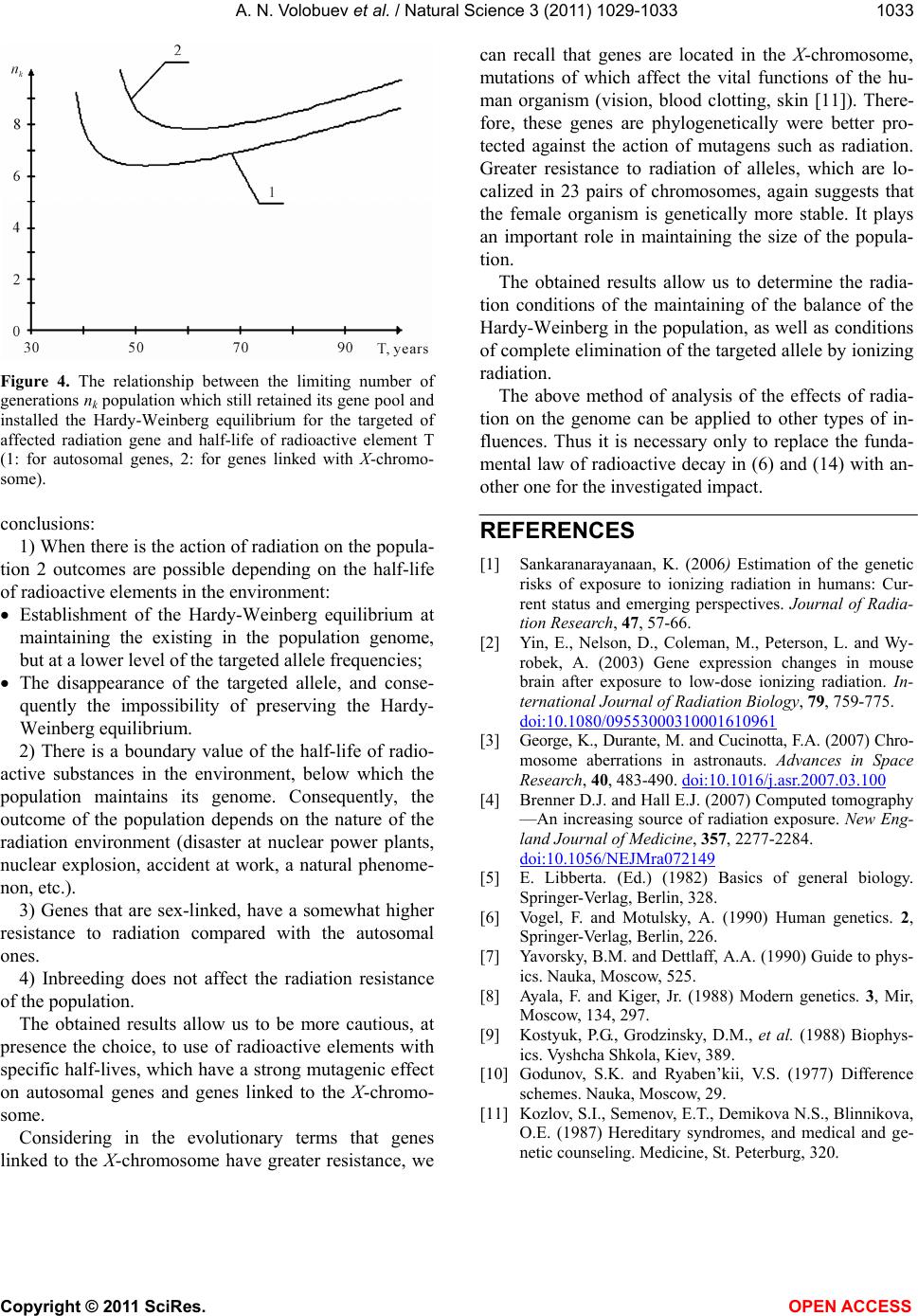
A. N. Volobuev et al. / Natural Science 3 (2011) 1029-1033
Copyright © 2011 SciRes. OPEN ACCESS
1031033
Figure 4. The relationship between the limiting number of
generations nk population which still retained its gene pool and
installed the Hardy-Weinberg equilibrium for the targeted of
affected radiation gene and half-life of radioactive element T
(1: for autosomal genes, 2: for genes linked with X-chromo-
some).
conclusions:
1) When there is the action of radiation on the popula-
tion 2 outcomes are possible depending on the half-life
of radioactive elements in the environment:
Establishment of the Hardy-Weinberg equilibrium at
maintaining the existing in the population genome,
but at a lower level of the targeted allele frequencies;
The disappearance of the targeted allele, and conse-
quently the impossibility of preserving the Hardy-
Weinberg equilibrium.
2) There is a boundary value of the half-life of radio-
active substances in the environment, below which the
population maintains its genome. Consequently, the
outcome of the population depends on the nature of the
radiation environment (disaster at nuclear power plants,
nuclear explosion, accident at work, a natural phenome-
non, etc.).
3) Genes that are sex-linked, have a somewhat higher
resistance to radiation compared with the autosomal
ones.
4) Inbreeding does not affect the radiation resistance
of the population.
The obtained results allow us to be more cautious, at
presence the choice, to use of radioactive elements with
specific half-lives, which have a strong mutagenic effect
on autosomal genes and genes linked to the X-chromo-
some.
Considering in the evolutionary terms that genes
linked to the X-chromosome have greater resistance, we
can recall that genes are located in the X-chromosome,
mutations of which affect the vital functions of the hu-
man organism (vision, blood clotting, skin [11]). There-
fore, these genes are phylogenetically were better pro-
tected against the action of mutagens such as radiation.
Greater resistance to radiation of alleles, which are lo-
calized in 23 pairs of chromosomes, again suggests that
the female organism is genetically more stable. It plays
an important role in maintaining the size of the popula-
tion.
The obtained results allow us to determine the radia-
tion conditions of the maintaining of the balance of the
Hardy-Weinberg in the population, as well as conditions
of complete elimination of the targeted allele by ionizing
radiation.
The above method of analysis of the effects of radia-
tion on the genome can be applied to other types of in-
fluences. Thus it is necessary only to replace the funda-
mental law of radioactive decay in (6) and (14) with an-
other one for the investigated impact.
REFERENCES
[1] Sankaranarayanaan, K. (2006) Estimation of the genetic
risks of exposure to ionizing radiation in humans: Cur-
rent status and emerging perspectives. Journal of Radia-
tion Research, 47, 57-66.
[2] Yin, E., Nelson, D., Coleman, M., Peterson, L. and Wy-
robek, A. (2003) Gene expression changes in mouse
brain after exposure to low-dose ionizing radiation. In-
ternational Journal of Radiation Biology, 79, 759-775.
doi:10.1080/09553000310001610961
[3] George, K., Durante, M. and Cucinotta, F.A. (2007) Chro-
mosome aberrations in astronauts. Advances in Space
Research, 40, 483-490. doi:10.1016/j.asr.2007.03.100
[4] Brenner D.J. and Hall E.J. (2007) Computed tomography
—An increasing source of radiation exposure. New Eng-
land Journal of Medicine, 357, 2277-2284.
doi:10.1056/NEJMra072149
[5] E. Libberta. (Ed.) (1982) Basics of general biology.
Springer-Verlag, Berlin, 328.
[6] Vogel, F. and Motulsky, A. (1990) Human genetics. 2,
Springer-Verlag, Berlin, 226.
[7] Yavorsky, B.M. and Dettlaff, A.A. (1990) Guide to phys-
ics. Nauka, Moscow, 525.
[8] Ayala, F. and Kiger, Jr. (1988) Modern genetics. 3, Mir,
Moscow, 134, 297.
[9] Kostyuk, P.G., Grodzinsky, D.M., et al. (1988) Biophys-
ics. Vyshcha Shkola, Kiev, 389.
[10] Godunov, S.K. and Ryaben’kii, V.S. (1977) Difference
schemes. Nauka, Moscow, 29.
[11] Kozlov, S.I., Semenov, E.T., Demikova N.S., Blinnikova,
O.E. (1987) Hereditary syndromes, and medical and ge-
netic counseling. Medicine, St. Peterburg, 320.